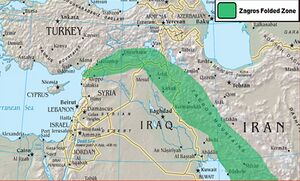Kerman
- For the ancient region see Karamania

Kirman or Kerman (Persian: كرمان, Kermān, Carmania) is a city in and capital of Kerman Province, Iran.
Location
Kerman is in the southeast of Iran with its administrative center in the city of Kerman.Mentioned in ancient times as the Achamenid satrapy of Carmania,[1] it is the second largest province of Iran.
Kerman is famous for its long history and strong cultural heritage. Kerman was formerly the capital of Iran during several periods of time.
The main townships of Kerman province are Baft, Bardsir, Bam, Jiroft, Rafsanjan, Zarand, Sirjan, Shahr-e-Babak, Kerman, Mahan, Rayen, Kahnuj, Ghale-Ganj, Manujan, Roodbar-e-Jonob, Anbar Abad, and Ravar.
Jat History
Bhim Singh Dahiya [2] quoting Buddha Prakash says, "The clan of Yaudheyas has an unmistakable resemblance with the Yautiya of Laristan, the Ouitioi of Trans-Caucasia, and the Jut nomads of Kirmans"[3].
Dr Girish Chandra Dwivedi [4] writes that The Khurdadba tells us that the Jat inhabitants skirting the route from Kirman to Mansura were entrusted with keeping watch over the route.[5]
Hukum Singh Panwar (Pauria) [6] writes that as per Census Report of India, 1931, The population of Jats in Kirman and Iraq was bout 20,000,
History
Kerman was founded as a defensive outpost, with the name Behdesīr, by Ardeshir I, founder of the Sassanid Empire, in the 3rd century AD. After the Battle of Nahāvand in 642, the city came under Muslim rule. At first the city's isolation allowed Kharijites and Zoroastrians to thrive there, but the Kharijites were wiped out in 698, and the population was mostly Muslim by 725. Already in the eighth century the city was famous for its manufacture of cashmere wool shawls and other textiles. The Abbasid Caliphate's authority over the region was weak, and power passed in the tenth century to the Buyid dynasty, which maintained control even when the region and city fell to Mahmud of Ghazna in the late tenth century. The name Kerman was adopted at some point in the tenth century.[7] The Masjid gate through which Agha Mohammad Khan entered the city.
Kerman was under the Seljuk Turks in the 11th and 12th centuries, but remained virtually independent, conquering Oman and Fars. When Marco Polo visited the city in 1271 it had become a major trade emporium linking the Persian Gulf with Khorasan and Central Asia. Subsequently, however, the city was sacked many times by various invaders. Kerman expanded rapidly during the Safavid Dynasty. Carpets and rugs were exported to England and Germany during this period.
जाट इतिहास
डॉ रणजीतसिंह[8] लिखते हैं... 'किताबुल मसालिक वअल ममालिक' पुस्तक के लेखक इब्न खुरदादबा की पुस्तक का हवाला देते हुए इलियट तथा डाउसन ने लिखा है कि "किरमान की सीमा से मनसूरा 80 प्रसंग है (8 मील का एक प्रसंग) यह मार्ग जाटों के देश से होकर निकलता है। वह इसकी चौकसी करते हैं।[9]
External links
References
- ↑ Carmani - . iranicaonline.org.
- ↑ Jats the Ancient Rulers (A clan study)/Jat Clan in India,p.277
- ↑ The Heritage of Persia, 1962, p. 50.
- ↑ The Jats - Their Role in the Mughal Empire/Introduction,p.12
- ↑ Ibn Khurdadba in Elliot, I, 14.
- ↑ The Jats:Their Origin, Antiquity and Migrations/Jat-Its variants, p.335
- ↑ A.H.T. Levi, "Kerman," in International Dictionary of Historic Places, ed. Trudy Ring, Chicago: Fitzroy Dearborn, 1995-1996, vol. 4, p. 413.
- ↑ Jat Itihas By Dr Ranjit Singh/1.Jaton Ka Vistar,p.5
- ↑ भारत का इतिहास प्रथम भाग (हिन्दी) इलियट एंड डाउसन, पृष्ठ 11.
Back to Jat Places in Iran

